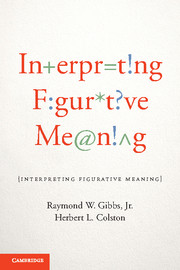Book contents
- Frontmatter
- Contents
- 1 Introduction
- 2 Identifying Figurative Language
- 3 Models of Figurative Language Comprehension
- 4 Interpreting Specific Figures of Speech
- 5 Indeterminacy in Figurative Language Experience
- 6 Factors Shaping Figurative Meaning Interpretation
- 7 Broadening the Scope of Figurative Language Studies
- References
- Index
4 - Interpreting Specific Figures of Speech
Published online by Cambridge University Press: 05 June 2012
- Frontmatter
- Contents
- 1 Introduction
- 2 Identifying Figurative Language
- 3 Models of Figurative Language Comprehension
- 4 Interpreting Specific Figures of Speech
- 5 Indeterminacy in Figurative Language Experience
- 6 Factors Shaping Figurative Meaning Interpretation
- 7 Broadening the Scope of Figurative Language Studies
- References
- Index
Summary
The dazzling array of figurative language types has generated several major bodies of empirical literature exploring how specific figures of speech are used and understood. Although ordinary speech and writing often contain multiple instances of different figurative meaning, even within a single utterance or sentence, psycholinguists and others have primarily isolated different figurative language types to explore the cognitive processes by which each type is produced and interpreted. This chapter describes some of the important contemporary research and theoretical debates over how people comprehend different types of figurative language. Our aim is to highlight some of the common ways and differences that various figures of speech are understood and to offer suggestions about the future of figurative language studies. There is, however, a vast range of topics and empirical methods for studying the different kinds of figurative meaning. This diversity makes it difficult to easily summarize the emerging trends in the study of figurative language more generally. As we have noted, the challenge is to create a theoretical framework that best captures different figurative meaning experiences. For the moment, let us dive into the complex literatures on specific figures of speech, and then step back to consider where matters may stand on the state of the art in figurative meaning studies.
METAPHOR
Metaphor has easily garnered the most interest among experimental psycholinguists studying figurative language. Numerous studies have explicitly examined the ways that the A, or target, and B, or vehicle, terms interact to produce metaphorical meaning for expressions like “My job is a jail” and “Lawyers are sharks.” A long-standing assumption in many academic fields is that metaphors are understood by recognizing the ways that topic and vehicle terms are similar. Thus, in understanding the metaphor “My job is a jail,” listeners are presumed to figure out the properties that jobs and jails share.
- Type
- Chapter
- Information
- Interpreting Figurative Meaning , pp. 128 - 191Publisher: Cambridge University PressPrint publication year: 2012

